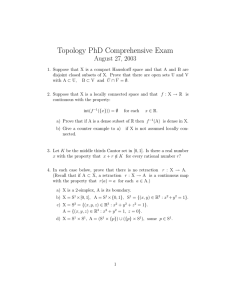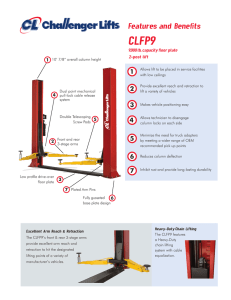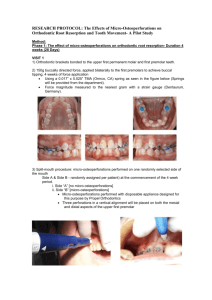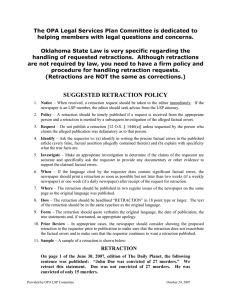Clinical study of a newly developed injection
advertisement
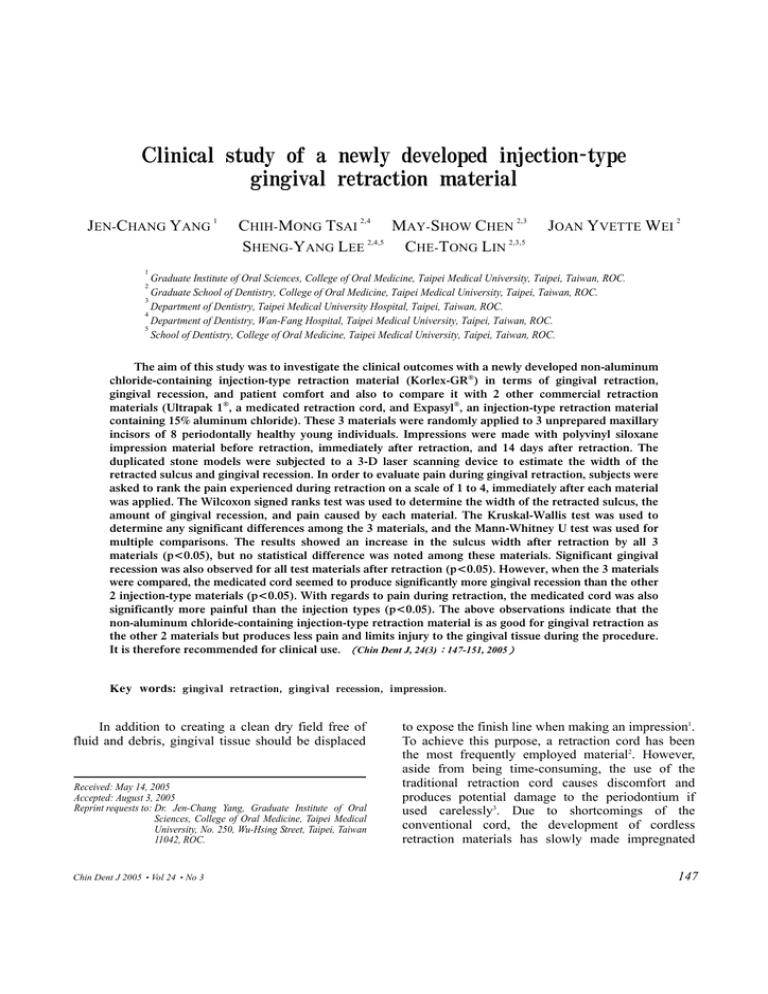
Clinical study of a newly developed injection-type gingival retraction material JEN-CHANG YANG 1 CHIH-MONG TSAI 2,4 MAY-SHOW CHEN 2,3 SHENG-YANG LEE 2,4,5 CHE-TONG LIN 2,3,5 JOAN YVETTE WEI 2 1 Graduate Institute of Oral Sciences, College of Oral Medicine, Taipei Medical University, Taipei, Taiwan, ROC. Graduate School of Dentistry, College of Oral Medicine, Taipei Medical University, Taipei, Taiwan, ROC. 3 Department of Dentistry, Taipei Medical University Hospital, Taipei, Taiwan, ROC. 4 Department of Dentistry, Wan-Fang Hospital, Taipei Medical University, Taipei, Taiwan, ROC. 5 School of Dentistry, College of Oral Medicine, Taipei Medical University, Taipei, Taiwan, ROC. 2 The aim of this study was to investigate the clinical outcomes with a newly developed non-aluminum chloride-containing injection-type retraction material (Korlex-GR®) in terms of gingival retraction, gingival recession, and patient comfort and also to compare it with 2 other commercial retraction materials (Ultrapak 1®, a medicated retraction cord, and Expasyl®, an injection-type retraction material containing 15% aluminum chloride). These 3 materials were randomly applied to 3 unprepared maxillary incisors of 8 periodontally healthy young individuals. Impressions were made with polyvinyl siloxane impression material before retraction, immediately after retraction, and 14 days after retraction. The duplicated stone models were subjected to a 3-D laser scanning device to estimate the width of the retracted sulcus and gingival recession. In order to evaluate pain during gingival retraction, subjects were asked to rank the pain experienced during retraction on a scale of 1 to 4, immediately after each material was applied. The Wilcoxon signed ranks test was used to determine the width of the retracted sulcus, the amount of gingival recession, and pain caused by each material. The Kruskal-Wallis test was used to determine any significant differences among the 3 materials, and the Mann-Whitney U test was used for multiple comparisons. The results showed an increase in the sulcus width after retraction by all 3 materials (p<0.05), but no statistical difference was noted among these materials. Significant gingival recession was also observed for all test materials after retraction (p<0.05). However, when the 3 materials were compared, the medicated cord seemed to produce significantly more gingival recession than the other 2 injection-type materials (p<0.05). With regards to pain during retraction, the medicated cord was also significantly more painful than the injection types (p<0.05). The above observations indicate that the non-aluminum chloride-containing injection-type retraction material is as good for gingival retraction as the other 2 materials but produces less pain and limits injury to the gingival tissue during the procedure. It is therefore recommended for clinical use. (Chin Dent J, 24(3):147-151, 2005) Key words: gingival retraction, gingival recession, impression. In addition to creating a clean dry field free of fluid and debris, gingival tissue should be displaced Received: May 14, 2005 Accepted: August 3, 2005 Reprint requests to: Dr. Jen-Chang Yang, Graduate Institute of Oral Sciences, College of Oral Medicine, Taipei Medical University, No. 250, Wu-Hsing Street, Taipei, Taiwan 11042, ROC. Chin Dent J 2005‧Vol 24‧No 3 to expose the finish line when making an impression1. To achieve this purpose, a retraction cord has been the most frequently employed material2. However, aside from being time-consuming, the use of the traditional retraction cord causes discomfort and produces potential damage to the periodontium if used carelessly3. Due to shortcomings of the conventional cord, the development of cordless retraction materials has slowly made impregnated 147 J.C. Yang, C.M. Tsai, M.S. Chen, et al. retraction cords less competitive. A cordless retraction material in the form of a paste-like material supplied with a specialized metal dispenser is commercially available. It displaces the gingiva by means of its high viscosity when injected into the sulcus4. Nevertheless, this commercial product contains as much as 15% aluminum chloride (AlCl3) which may be hazardous to gingival tissue5. The high cost of the product also prevents it from becoming a mainstream commodity. New injection-type materials for gingival retraction with little or no AlCl3 have recently been developed. Analyses of the behavior and physical properties as well as cytotoxicity tests have already been carried out to affirm their safety. Results of animal studies have demonstrated their effectiveness as a material for gingival retraction6. This study aimed to compare the clinical feasibility and efficacy of 3 gingival retraction materials (1 medicated retraction cord and 2 injection types: one with 15% AlCl3 and the other without, respectively) in terms of sulcus width, gingival recession, and patient discomfort. MATERIALS AND METHODS Subjects and materials This study was performed on 8 healthy, nonsmoking subjects (4 males and 4 females, aged 25±2.26 years) with good oral hygiene. Subjects were asked to sign written informed consent prior to the clinical trial. They were screened for periodontal health on their first visit according to the criteria of the Silness and Loe plaque index and the Loe and Silness gingival index7. Subjects had healthy gingiva (no calculus or plaque deposition, of a pale-pink color, with knife-edged papilla, and no swelling or bleeding) and the absence of deep periodontal pockets (pocket depths of < 3 mm). All subjects had been educated on how to maintain good oral hygiene. A preliminary impression was made using polyvinyl siloxane impression material for fabrication of a custom tray for each subject. Three retraction materials, namely an epinephrine-impregnated cord (Ultrapak 1®, Ultradent Products, South Jordan, Utah, USA), an injectiontype material with 15% AlCl3 (Expasyl®, SatelecPierre Roland, Merignac Cedex, France), and an 148 injection-type material with 0% AlCl3 (Korlex- GR®, Biotech-One, San-Chung, Taiwan), were used for gingival retraction in this study. The use of a retraction cord is very technique-sensitive. To minimize pain or pressure on the test sites, the cord was packed by a well-experienced prosthodontist. Each subject received all 3 types of retraction materials, which were randomly placed on the labial surface of 1 of the unprepared maxillary right or left central or lateral incisors in each subject. In total, 24 teeth were used in this study. Procedures A double-phase impression technique using polyvinyl siloxane impression material was employed with a customized tray for each subject. The tray was first loaded with heavy-bodied rubber impression material (Take-One, Kerr, Romulus, Michigan, USA), seated with light pressure on the test site, and allowed to remain in place until the material had set. Light-bodied rubber impression material (Take-One, Kerr) was intruded into a plastic syringe (GC, Kasugai, Aichi, Japan) from which it was injected into the sulcus and around the tooth. A piece of a thin transparent plastic sheet (about 0.2 mm thick) was also placed on top of the heavy-bodied impression material to prevent it from coming in direct contact with the teeth while taking the impression. The heavy-bodied rubber impression material in the custom tray was also filled with light-bodied impression material and placed into position. The tray was held gently in position for 5 minutes before separation. In total, 3 impressions were taken from each subject to duplicate 3 stone models with improved dental stone (Diekeen, Heraeus, Kulzer, Germany). The first impression was taken prior to gingival retraction, and dental stone was used which served as the control. The selected teeth were isolated, and each retraction material was randomly and separately placed on 1 of the 3 teeth. The retraction materials were pressed into the gingival sulcus to a depth of approximately 1 mm and allowed to stay in position for 2 minutes. The cord was manually removed while the retraction pastes were copiously irrigated with water until no traces of the material was left. The teeth were air-dried, and a second impression was made immediately afterwards. The second duplicated stone model served to register the width of the Chin Dent J 2005‧Vol 24‧No 3 Injection-type gingival retraction material retracted sulcus. Fourteen days after gingival retraction, a third impression was made in the same way except that the gingiva was not retracted this time. From the third impression, a third stone model was poured to register the position of the gingival margin 14 days after retraction to determine gingival recession. Each stone model was subjected to a 3-D non-contact laser scan (WIZprobe, Nextec, Tel Aviv, Israel) to measure the width of the retracted sulcus and the position of the gingival margin. By using image processing techniques and shape measurement algorithms, a dense 3-D point cloud representing the surface of the object could be constructed and exported to AutoCAD software. To determine the gingival retraction, the images of the first and second stone models were superimposed, with the 2 incisal angles and the labial surface serving as references. By selecting and enlarging the image of the cervical area around the gum, the distance between the crest of the gingiva to the tooth surface of both the first and second images were obtained under a distance-measurement mode. The maximum difference was recorded and considered to be the amount of gingival retraction (Figure 1). To determine gingival recession, the images of the first and third stone models were superimposed using the same procedure. The greatest vertical distance between the gingival margins of the 2 superimposed images indicated the amount of gingival recession (Figure 2). To evaluate pain, subjects were asked about the pain perceived during retraction immediately after each material was applied based on a scale of 1 to 4 (1, no pain; 2, mild pain; 3, moderate pain; 4, severe pain). Statistical analysis The Wilcoxon signed ranks test was used to evaluate gingival retraction, gingival recession, and pain caused by each material. The Kruskal-Wallis test was used to determine differences among the 3 retraction materials, and the Mann-Whitney U test Figure 1. Superimposed images of the first (red) and second (blue) scanned stone models. The distance between the tips of the 2 arrows reflects gingival retraction. Chin Dent J 2005‧Vol 24‧No 3 Figure 2. Superimposed images of the scanned first (blue) and third (black) stone models. The distance between the tips of the 2 arrows reflects gingival recession. 149 J.C. Yang, C.M. Tsai, M.S. Chen, et al. was used for multiple comparisons. All values in this paper are presented as the median (first quartile, third quartile). RESULTS Values of gingival retraction produced by the 3 different materials namely Ultrapak 1®, Expasyl® and Korlex-GR® were 0.28 (0.26, 0.34), 0.29 (0.21, 0.33), and 0.25 (0.23, 0.27) mm, respectively. There was a significant increase in the sulcus width after retraction with all 3 materials (Table 1). Values of gingival recession observed with Ultrapak 1®, Expasyl®, and Korlex-GR® after retraction were 0.19 (0.17, 0.30), 0.06 (0.04, 0.07), and 0.05 (0.03, 0.08) mm, respectively (Table 2); all 3 materials produced significant gingival recession (p < 0.05). Ultrapak 1® produced the greatest amount of recession, and it was significantly greater than that produced by Expasyl® or Korlex-GR®. The use of Ultrapak 1® was also significantly more painful compared to the other 2 materials (p < 0.05). DISCUSSION In this study, all 3 materials produced a significant increase in the sulcus width of > 0.2 mm, and no significant difference was noted among the test materials. Previous studies have suggested that a sulcus width greater than 0.2 mm is necessary to obtain an accurate impression, and that the impression should have a minimum thickness of 0.2 mm in order to resist deformation during pouring of the dental stone8. Our findings suggest that the non-AlCl3-containing injection-type retraction material is as good as the 2 other commercial brands in terms of retracting the gingival sulcus. Among the materials, the epinephrine-impregnated cord demonstrated the greatest amount of gingival recession while the gingival recession observed in the 2 injection-type retraction materials was considered clinically insignificant and was too small to be visible to the naked eye. This minimal recession would neither create a problem with the marginal fitness of the final fixed prosthesis nor affect the esthetic result. Pain is considered a subjective feeling or Table 1. Comparison of gingival retraction among the 3 materials (mm) Gingival retraction median (q1, q3) Ultrapak1® Expasyl® Korlex-GR® 0.28 (0.26, 0.34)* 0.29 (0.21,0.33)* 0.25 (0.23,0.27)* * p < 0.05, by Wilcoxon signed ranks test, in a comparison of gingival retraction before and after placement of the materials. Table 2. Comparison of gingival recession among the 3 materials (mm) Gingival recession median (q1, q3) Ultrapak1® Expasyl® Korlex-GR® 0.19 (0.17, 0.30)* 0.06 (0.04, 0.07)*† 0.05 (0.03, 0.08)*† * p < 0.05, by Wilcoxon signed ranks test, in a comparison of gingival recession before and after placement of the materials. † p < 0.05, by Mann-Whitney U test, in a comparison with Ultrapak1®. Table 3. Pain assessment of the 3 materials Pain median (q1, q3) Ultrapak1® Expasyl® Korlex-GR® 3 (3, 3) 1 (1, 1)† 1 (1, 1)† † p < 0.05, by Mann-Whitney U test, in a comparison with Ultrapak1® 150 Chin Dent J 2005‧Vol 24‧No 3 Injection-type gingival retraction material experience; therefore it is quite difficult to standardize conditions to assess it. We classified pain felt during the retraction into 4 ranks, from no pain to severe pain. It was evaluated based on subjective feedback. In order to insert the retraction cord into the gingival sulcus, concentrated mechanical pressure applied to the delicate gingival tissue is almost clinically unavoidable. Our results indicated that the use of the medicated cord was more painful than the injection types. This result confirms the clinical convenience and comfort of injection-type retraction materials. The AlCl3 concentration in the injection-type, Expasyl® is as high as 15%, and is designed especially for the purpose of hemostasis. It was suggested that a concentration greater than 10% is hazardous to soft tissue5. Although tissue injury caused by the high AlCl3 content was not evident in this study, and subjects enrolled in this study had healthy gingiva, a cytotoxicity test and review of the literature indicate that an inflammatory cell response or cytotoxic reactions under a microscope can occur when high concentrations are used5. It is possible that gingival damage may become evident when the reparative ability or tissue resistance of the host body is diminished. This emphasizes the need to develop biomaterials containing fewer chemical agents in the future. Korlex-GR® contains no AlCl3, and it was able to produce satisfactory gingival retraction without the drawbacks of pain and gingival recession, suggesting that the newly developed injection-type retraction material is a better choice in terms of potential soft tissue damage. Chin Dent J 2005‧Vol 24‧No 3 CONCLUSIONS This study indicates that the newly developed injection-type retraction material ensures adequate sulcus retraction favorable for making impressions in the majority of clinical situations. Local anesthesia is not required since the application of the material is painless. Gingival recession is minimal, which makes the material suitable for gingival retraction of anterior as well as posterior teeth. Based on the above results, the application of the newly developed injection-type retraction material as a gingival retraction agent is clinically feasible. REFERENCES 1. Benson BW. Tissue displacement methods in fixed prosthodontics. J Prosthet Dent, 55(2): 175-181, 1986. 2. Donovan TE, Gandara BK, Nemetz H. Review and survey of medicaments used with gingival retraction cords. J Prosthet Dent, 53(4): 525-531, 1985. 3. Azzi R. Comparative study of gingival retraction methods. J Prosthet Dent, 50(4): 561-565, 1983. 4. Lesage P. Expasyl: Protocol for use with fixed prosthesis. Clinic, 23: 97-103, 2002. 5. Kopac I. Viability of fibroblasts in cell culture after treatment with different chemical retraction agents. J Oral Rehabil, 29(1): 98-104, 2002. 6. Yang JC, Weng CW, Chen CC. Animal study of newly developed injectable gingival retraction material. Chin Dent J, 22: 471-475, 2004. 7. Spolsky VW. Epidemiology of gingival and periodontal disease. Clin Periodon, 8: 61-81, 2000. 8. Laufer BZ, Baharav H, Cardash HS. The linear accuracy of impressions and stone dies as affected by the thickness of the impression margin. Int J Prosthod, 7(3): 247-252, 1994. 151
